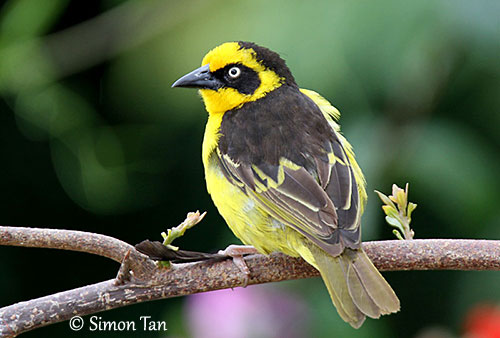
Fr: Tisserin baglafecht
Ang: Baglafecht Weaver
All: Baglafechtweber
Esp: Tejedor Baglafecht
Ita: Tessitore baglafecht
Nd: Baglafechtwever
Sd: baglafechtvävare
Photographers:
Jean Michel Fenerole
Photos d’Oiseaux du monde
Steve Garvie
RAINBIRDER Photo galleries
Ken Havard
My Bird Gallery & Flickr gallery 1 & Flickr gallery 2
William Price
PBase-tereksandpiper & Flickr William Price
Dubi Shapiro
Dubi Shapiro Photo Galleries
Philip Stapelberg
GALLERY
Simon Tan
PBase Bird galleries
Text by Nicole Bouglouan
Sources:
HANDBOOK OF THE BIRDS OF THE WORLD Vol 15 by Josep del Hoyo-Andrew Elliot-David Christie - Lynx Edicions – ISBN: 9788496553682
BIRDS OF AFRICA SOUTH OF THE SAHARA by Ian Sinclair and Peter Ryan - Princeton University Press Princeton and Oxford - ISBN: 0691118159
BIRDS OF THE GAMBIA AND SENEGAL by Clive Barlow and Tim Wacher – Helm Field guides – ISBN: 0713675497
Birds of the Serengeti: And Ngorongoro Conservation Area by Adam Scott Kennedy – Editeur: Princeton University Press, 2014 – ISBN: 0691159106 – 9780691159102 – 224 pages
Field Guide to the Birds of East Africa: Kenya, Tanzania, Uganda, Rwanda, Burundi by Terry Stevenson, John Fanshawe – Editeur: Bloomsbury Publishing, 2020 – ISBN: 1472986628 - 9781472986627 – 624 pages
Common Birds: the case of the Baglafecht Weaver and missing forests
Arthur Grosset's Birds (Arthur Grosset)
Wikipedia, the free encyclopaedia
Baglafecht Weaver
Ploceus baglafecht
Passeriformes Order – Ploceidae Family
INTRODUCTION:
The Baglafecht Weaver was first described by Buffon in 1775, and was named “Le Baglafecht”. Buffon noted that this species came from Abyssinia (Ethiopia).
James Bruce, a Scottish traveller in North Africa and Ethiopia, wrote some books and painted numerous plants and animals seen during his trips. He collected the Baglafecht Weaver in 1768-1773, when he was in Ethiopia.
A biography on Bruce (1808) mentioned the painting of a bird named “yellow Bagla finch”, and this illustration has been probably the source of the description of this bird by Buffon.
The name “Baglafecht” probably comes from a native Abyssinian name.

The Baglafecht Weaver shows wide variation of plumage through eight subspecies. However, all subspecies have black face and yellow eyes, but the juveniles have dark eyes.
This species frequents forest clearings and edges, cultivated lands, urban gardens, marshes and highland areas. It is primarily an insect-eater, but seeds and nectar from flowers are also part of the diet. Insects are caught by gleaning and probing into bark crevices and clusters of dead leaves.
The Baglafecht Weaver is monogamous, territorial and solitary nester. The male builds an oval-shaped nest with side entrance and later, the lining is made by the pair. Both parents feed the young.
The Baglafecht Weaver is described as common and widespread in most regions and currently, the species is not globally threatened.
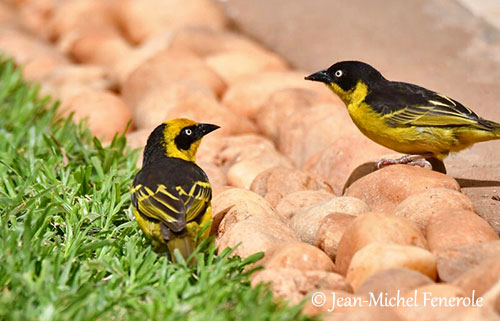
DESCRIPTION OF THE BIRD:
Biometrics:
Length: 15 cm
Weight: 24-37 g
The Baglafecht Weaver male of nominate race in breeding plumage has olive-green upperparts, but the feathers of both mantle and back have dark centres, forming faint streaking. On the dark brown upperwing, the flight-feathers are edged yellow whereas the wing-coverts show broad greenish edges. The tail is olive-green.
The underparts are bright yellow from chin to undertail-coverts, slightly brighter on breast.
On the golden-yellow head, we can see a contrasting black mask extending from the bill, through the eye and onto the ear-coverts.
The pointed bill is black. The eyes are pale yellow. Legs and feet are brown.
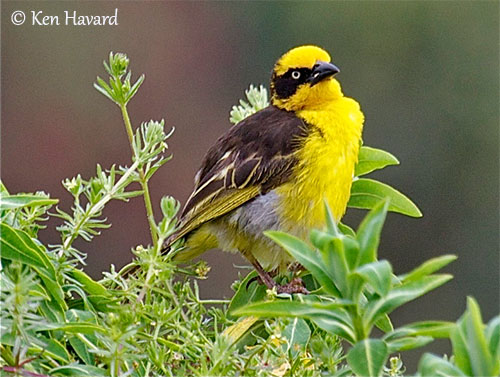
The male in non-breeding plumage has ashy-grey upperparts with dusky streaks on mantle and back. Wings and tail are as in breeding plumage.
On the underparts, chin, throat and breast are buffy, whereas belly, flanks, thighs and undertail-coverts are whitish.
There is a buffy wash on head sides and no differentiated mask.
The bare parts are as in breeding plumage.
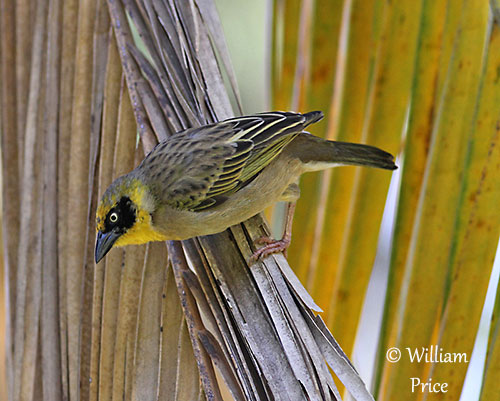
The female in breeding plumage resembles breeding male but with greenish forehead and crown, dull black mask with green wash around the eyes.
The non-breeding female resembles non-breeding male.
The juvenile/immature does not have mask on the dark yellowish-green head, but the lores are black.
The upperparts are dark brown with faintly streaked mantle and back. The underparts, including the throat, are dull white.
Bill, legs and feet are brown. The eyes are brown.
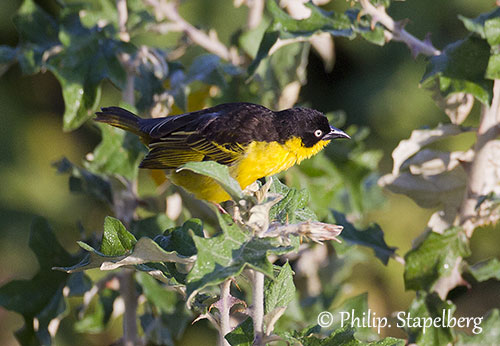
SUBSPECIES AND RANGE:
The Baglafecht Weaver has 8 recognized subspecies that differ mainly in the colour of male’s head (yellow or black crown), and green or black upperparts.
P.b. baglafecht (described above) occurs in Ethiopia highlands and S Eritrea.
P.b. neumanni is found in E Nigeria, Cameroon and Central African Republic.
This one has brighter green upperparts, paler yellow forehead and well defined white area on belly than nominate.
P.b. eremobius is found in DR Congo and SW Sudan.
This race is smaller. The underparts from lower breast to undertail-coverts are white.
P.b. emini is also called Emin’s Weaver. It occurs in SE Sudan and N Uganda.
The male of this race has yellow crown and black mask. The area from nape to back is black. Some feathers of mantle and back have pale edges. The rump is grey.
Chin and breast are golden-yellow. Belly to undertail-coverts is white.
The breeding female has black forehead and crown.
P.b. reichenowi is found in the highlands of Kenya and N Tanzania.
The male has golden-yellow forehead, crown and thin area behind the ear-coverts, involving a black patch around the eye.
The female has black crown and forehead continuous with face mask.
Both sexes have black nape and upperparts, faint yellow flecking on rump, and whitish to yellow eyes. They have the same plumage all year round.
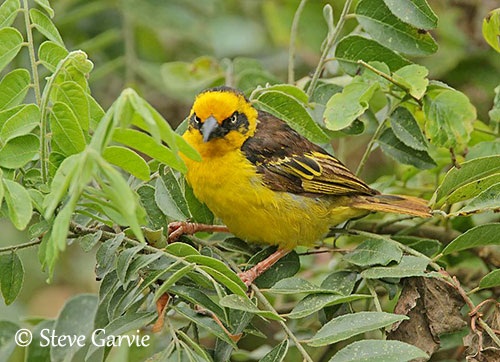
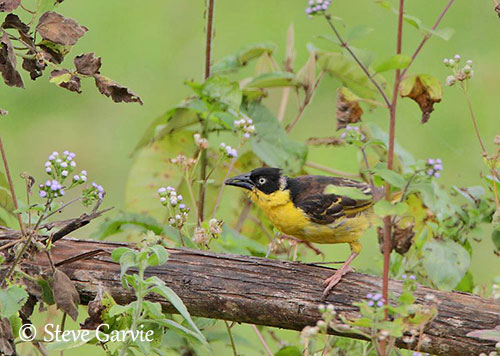
P.b. stuhlmanni is also named Stuhlmann’s Weaver. It is found in E DR Congo to S Uganda and W Tanzania.
This race has black crown and forehead blending into face mask. The female has duller crown.
Both sexes have yellowish nape and upperparts, and paler yellow underparts. No seasonal change in plumage.
P.b. sharpii is found in montane forests of SW Tanzania.
This one resembles previous, but the breeding male has greener upperparts and paler yellow underparts. No seasonal change in plumage.
P.b. nyikae is found on Nykia Plateau of Zambia and Malawi.
This race is dark-capped like previous two races, but flanks, thighs, belly and undertail-coverts are greyish.
HABITAT:
The Baglafecht Weaver frequents forest clearings and edges, and areas with open vegetation outside of forest. It can be seen in urban gardens too.
Depending on the range, it also frequents marshes and montane highlands. The species occurs mainly in highland areas. In Cameroon, it can be seen between 1,400 and 2,300 metres of elevation on mountain slopes with scattered vegetation, but also in clearings and near villages.
In Ethiopia, it occurs above 1,200 metres, mostly between 800 and 3,000 metres in Kenya and Uganda, and not below 1,800 metres in Zambia and Malawi.
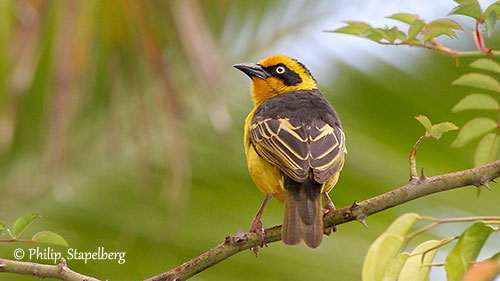
CALLS AND SONGS: SOUNDS BY XENO-CANTO
The Baglafecht Weaver’s common call in Kenya is a chatter described as “swii chee chee cheechit” and both mates communicate with “pseet” or “shreeep” contact calls. The alarm call is “swii chit”.
The song is a chattering mixed with musical notes, often given in two or three-part series.
There is little difference between the races.
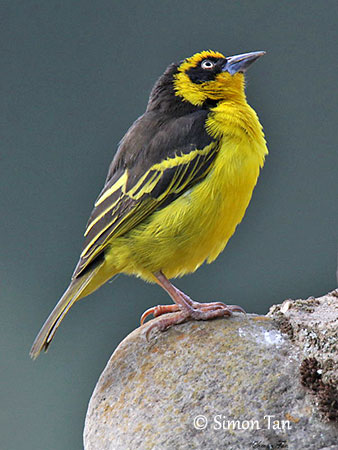
BEHAVIOUR IN THE WILD:
The Baglafecht Weaver is primarily an insect-eater, but it also takes seeds and various plant matter including fruit and nectar from flowers.
Insects are caught by probing into clusters of dead leaves or bark crevices, but the bird also gleans leaves and branches. The nectar is taken by dipping the bill into open flowers.
During the breeding season, the young are fed on spiders and various insect species.
In Kenya, the Baglafecht Weaver is known to damage seedlings and growing peas.
It usually forages alone or in pairs, but after breeding, adults and young form small groups of 8-10 individuals or sometimes join mixed-species flocks.
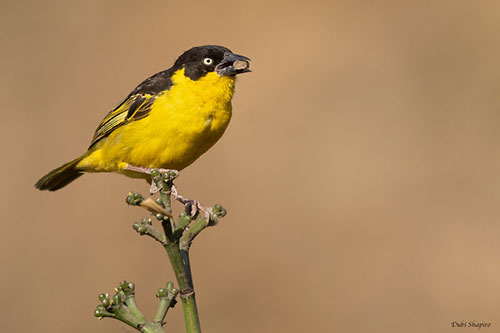
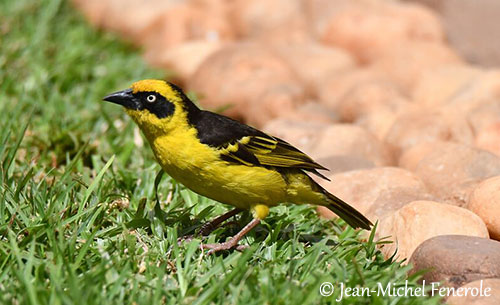
The Baglafecht Weaver is monogamous and usually breeds singly rather than in colonies. The species is known to be highly territorial.
The male displays from the nest by using both long and short songs. Near the nest, it performs an upright wing-beating display to the female.
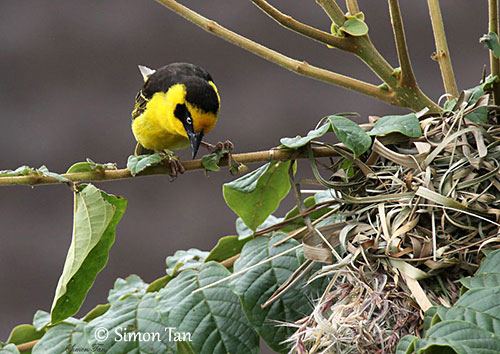
The nest is built by the male, an oval-shaped structure with side-entrance. Several nests are sometimes built at a site, but some of them are used for roosting. Both parents take part in nesting duties.
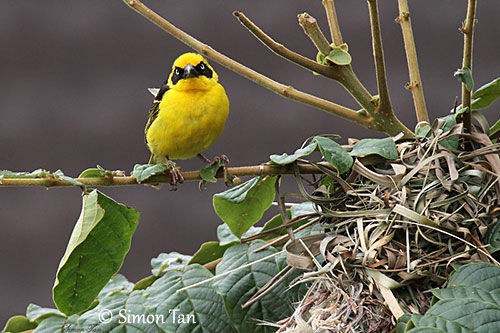
The Baglafecht Weaver is probably resident.
The flight is usually fast but this species does not fly over long distances.
REPRODUCTION OF THIS SPECIES:
The breeding season varies depending on the range.
The Baglafecht Weaver is monogamous, territorial and solitary nester, although two pairs may occasionally nest in the same area.
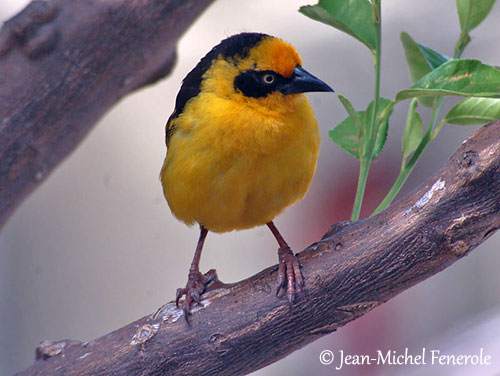
Male and female select the nest-site, but the nest is built by the male alone. It is an oval structure slightly flattened below and with a side entrance. There is an internal ledge to protect the eggs from rolling out.
The male weaves green grass stems or broad strips from grass blades. The lining is made by both adults with plant down and some feathers until forming a bowl. Both ceiling and bowl are lined with grass seedheads.
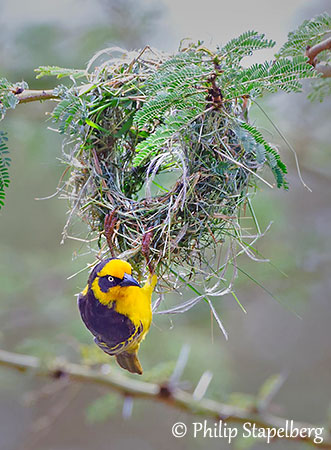
The nest is built between 3 and 6 metres above the ground. It is usually suspended by grass stems looped around a branch, or attached to banana leaves. It is often built in Acacia, sometimes in palm, exotic pine (Pinus) or Eucalyptus. It is generally concealed in dense foliage.
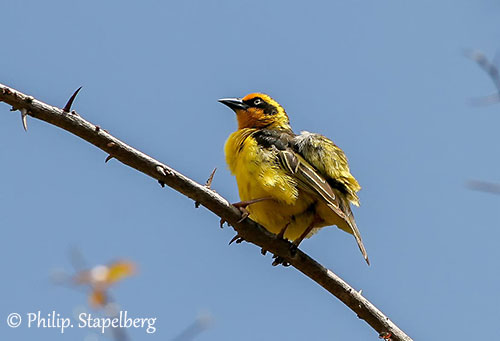
The female lays 1-3 eggs. They are plain blue-green with dark brown markings, or white to pinkish with reddish-brown markings. She incubates alone during 11-12 days, while the male remains perched in the vicinity of the nest. At hatching, the chicks are fed by the female during the first four days. Then, the male also feeds them. The nestling period lasts about 15-17 days.
If the female starts a new clutch, the male takes care of the fledglings.
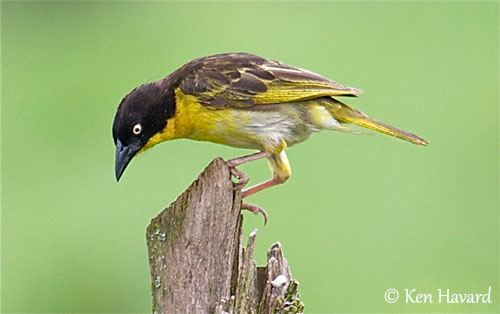
PROTECTION / THREATS / STATUS:
The Baglafecht Weaver is described as common to abundant in most of the range, especially in N and E, whereas it is scarce to uncommon in W.
It is observed in urban gardens and disturbed habitats, and seems to be fairly adaptable.
The size of the population is unknown, but it is suspected to be stable.
The Baglafecht Weaver is currently evaluated as Least Concern.
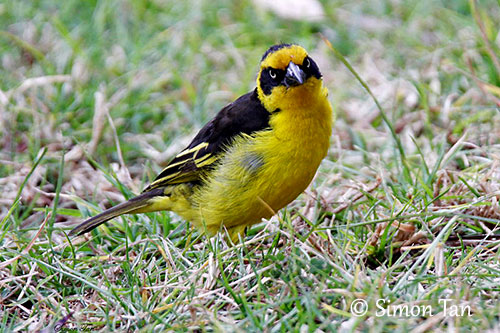
P.b. reichenowi
Male
P.b. reichenowi
Female